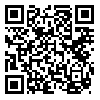Volume 76, Issue 3 (June 2018)
Tehran Univ Med J 2018, 76(3): 197-203 |
Back to browse issues page
Download citation:
BibTeX | RIS | EndNote | Medlars | ProCite | Reference Manager | RefWorks
Send citation to:



BibTeX | RIS | EndNote | Medlars | ProCite | Reference Manager | RefWorks
Send citation to:
Jaffary F, Nilforoushzadeh M A, Abdellahi L, Tahmasebi Poor H. Antimonial treatment failure rate in patients with cutaneous leishmaniasis. Tehran Univ Med J 2018; 76 (3) :197-203
URL: http://tumj.tums.ac.ir/article-1-8834-en.html
URL: http://tumj.tums.ac.ir/article-1-8834-en.html
1- Skin Diseases and Leishmaniasis Research Center, Isfahan University of Medical Sciences, Isfahan, Iran. Skin and Stem Cell Research Center, Tehran University of Medical Sciences, Tehran, Iran.
2- Skin and Stem Cell Research Center, Tehran University of Medical Sciences, Tehran, Iran.
3- Skin Diseases and Leishmaniasis Research Center, Isfahan University of Medical Sciences, Isfahan, Iran. ,latifeabdellahi@yahoo.com
4- Faculty of Medicine, Najafabad Branch, Islamic Azad University, Najafabad, Iran.
2- Skin and Stem Cell Research Center, Tehran University of Medical Sciences, Tehran, Iran.
3- Skin Diseases and Leishmaniasis Research Center, Isfahan University of Medical Sciences, Isfahan, Iran. ,
4- Faculty of Medicine, Najafabad Branch, Islamic Azad University, Najafabad, Iran.
Abstract: (3550 Views)
Background: Despite advances in diagnosis and treatment, leishmaniasis is now considered a severe public health problem, particularly in developing countries, such as Iran. Leishmaniasis is among the six most important, parasitic diseases of the world affecting 88 countries in almost every continent. The disease is complex with different clinical presentations such as visceral, cutaneous and mucocutaneous forms. Cutaneous leishmaniasis (CL) is the most common form of the disease in Iran. Antimony compounds are the first line treatment of CL. The treatment of leishmaniasis in endemic areas relies on chemotherapy, and in several parts of the world the mainstay remains the pentavalent antimony (SbV)-containing drugs Pentostam (sodium stibogluconate) and Glucantime (meglumine). There is no comprehensive study on treatment failure rate of this compounds. This study was designed to evaluate treatment failure rate and possible involving factors of antimonial resistance in CL to facilitate and improve treatment strategies of this disease.
Methods: All patients with CL referred to Skin Disease and Leishmaniasis Research Center (SDLRC), from October 2011 to October 2013, treated with antimony compounds were assessed in this study. Patient characteristics (gender, age and place of residence), number, type and location of the lesions, comorbidities and type of treatment were recorded and analyzed.
Results: Rate of treatment failure with Meglusan was 4.3%. Failure rate in men and in patients with previous history of cutaneous leishmaniasis was more than women or patients without CL history (P= 0.000, 0.024 respectively). The results of this study showed that treatment failure was higher in patients with systemic treatment than intralesional (IL) or combination therapy (both IL and systemic treatment) group but this difference was not statistically significant. Also, size and number of the lesions, wound infection, the patient's age, location, education and occupation do not have a significant correlation with treatment failure.
Conclusion: Greater treatment failure rate of Meglusan compared to Glucantime (4.3% versus< 1%, respectively) is an important issue to be considered in CL therapeutic strategy.
Methods: All patients with CL referred to Skin Disease and Leishmaniasis Research Center (SDLRC), from October 2011 to October 2013, treated with antimony compounds were assessed in this study. Patient characteristics (gender, age and place of residence), number, type and location of the lesions, comorbidities and type of treatment were recorded and analyzed.
Results: Rate of treatment failure with Meglusan was 4.3%. Failure rate in men and in patients with previous history of cutaneous leishmaniasis was more than women or patients without CL history (P= 0.000, 0.024 respectively). The results of this study showed that treatment failure was higher in patients with systemic treatment than intralesional (IL) or combination therapy (both IL and systemic treatment) group but this difference was not statistically significant. Also, size and number of the lesions, wound infection, the patient's age, location, education and occupation do not have a significant correlation with treatment failure.
Conclusion: Greater treatment failure rate of Meglusan compared to Glucantime (4.3% versus< 1%, respectively) is an important issue to be considered in CL therapeutic strategy.
Type of Study: Original Article |
Send email to the article author
| Rights and permissions | |
 |
This work is licensed under a Creative Commons Attribution-NonCommercial 4.0 International License. |





